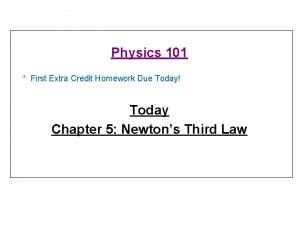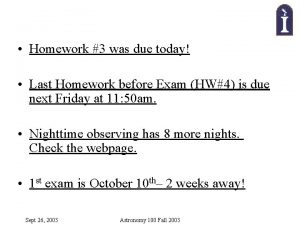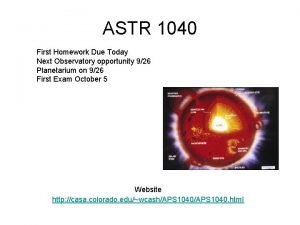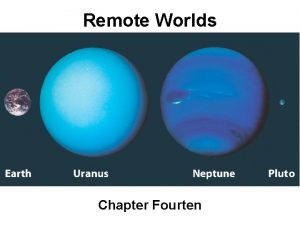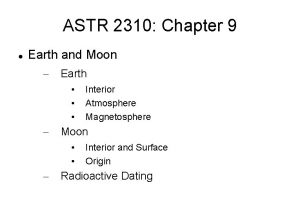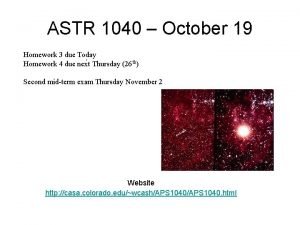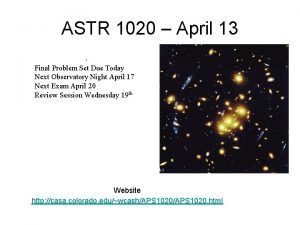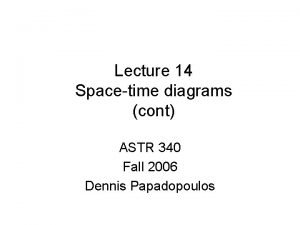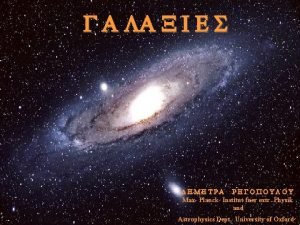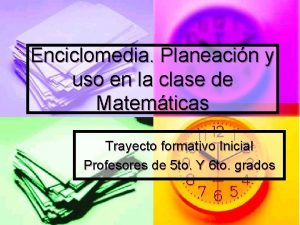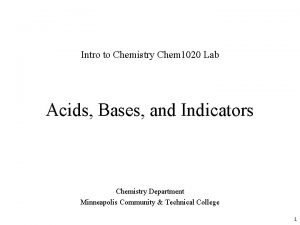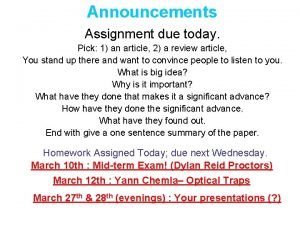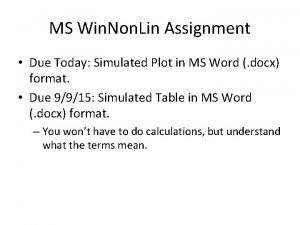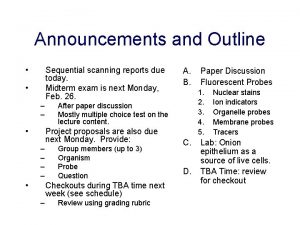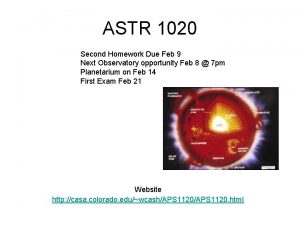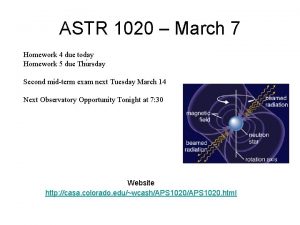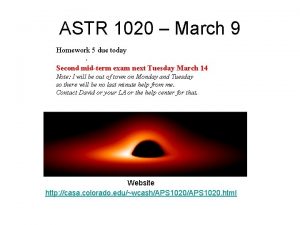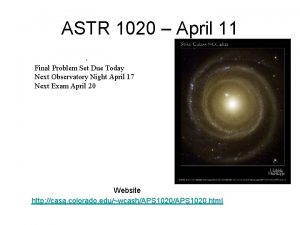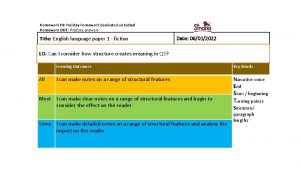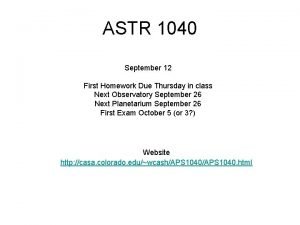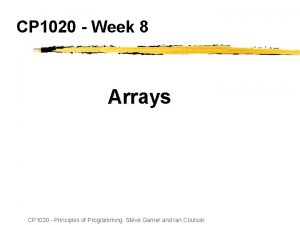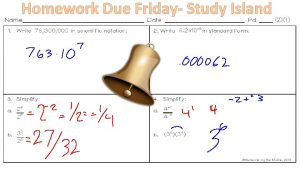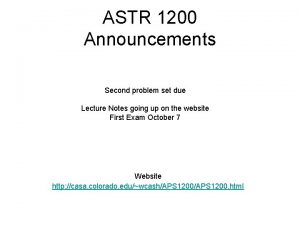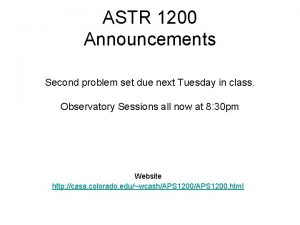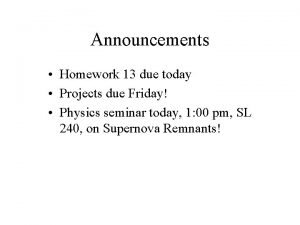ASTR 1020 First Homework Due Today Second Homework






























































- Slides: 62

ASTR 1020 First Homework Due Today Second Homework due Feb 9 Next Observatory Session Tonight at 7 pm Website http: //casa. colorado. edu/~wcash/APS 1020. html

Escape Velocity R Fall from Large Height Same Energy Needed to Reverse and Fly Away Escape velocity is the speed at which object must be thrown upward to escape and never come down. G=6. 7 x 10 -11 in mks units

The Sun

The Sun Falls into “Disk Stability” 99. 9% Ended in Sun (0. 1% in Jupiter) Probably the Same Around All Stars -- Planets are Common Shoots Planet-Size Bullets into Space

Most of Mass Forms Ball in Center A Star Is a Hot Ball of Hydrogen (plus 11% Helium) One Million Miles

What Stops the Fall? Gravity Gets Stronger As Material Gets More Dense R smaller implies F greater The smaller it gets, the faster it falls in! Why doesn’t it just become a black hole? Or worse yet, a point-like singularity of mass?

Scaling Scientists often do “scaling” do avoid all those large numbers. For example, the Sun is ABOUT a million times the mass of the Earth and a hundred times the size.

Question What is the surface gravity of the Moon in gees? R=. 01 Re, M=. 25 Me? a). 04 b)4 c)16 d). 16

Answer d

Temperature is a Measure of the Random Kinetic Energy per Particle The faster the atoms move, the higher the temperature. But we’re talking about random motion. If they all move together, then the object moves.

Thermal Pressure Thermal Gas Pressure Balances Gravitational Pressure Balloon Every Time An Bounces Off Edge of Balloon It Keeps It From Collapsing That’s Pressure is Force per Unit Area

Pressure is Proportional to Temperature Low Temperature Atoms Move Slowly High Temperature Atoms Move Fast

A Star Is Held Up By Thermal Pressure From Below Outer Mass Gravity Individual Atoms Don’t Orbit Entire Inside of Star Like This They Jostle Each Other But Effect Is The Same

Temperature Scales • Fahrenheit – – 0=salt water freeze 100=human body • Celsius – – 0=pure water freeze 100=water boil (sea level) C=(F-32)x 5/9 • Kelvin – – – 0=absolute zero 100 degrees between freeze and boil K=C+273 -273 C = 0 K = Absolute Zero Atoms Stop Moving

Thermal Pressure Ideal Gas Law Chemistry Style Ideal Gas Law Physics Style P V n R T Pressure Volume # moles Constant Temperature (K) P V N k T Pressure Volume # atoms Constant Temperature (K) Pressure Is Proportional to Temperature x Density

Pressure Balance A Star Always Balances Gravitational Pressure with Thermal Pressure At Each Point Inside Thermal Pressure (Jostling) Gravity

But We Have a Problem The Sun is Luminous Radiates Energy Into Space Luminosity is Power Radiated -- ergs/second The Energy Comes From Motion of the Atoms Temperature Drops What Happens When T Drops?

Luminosity Effect When T Drops Thermal Pressure Can’t Hold Off Gravity The Sun Shrinks -- Radius Drops Energy is Released as Gas Falls Deeper Into Gravity Field Temperature Rises Note – Loss of Energy Results in a) Temperature Rise b) Radius Decrease

But Wait A Minute… Isn’t the Sun Stable? The Sun has been remarkably stable for 4 billion years as evidenced by geological records. This collapse is the process by which the Sun coalesced. But then it stopped. Why? The Sun collapsed until a new source of energy offset the losses to radiation. NUCLEAR FUSION --- IT’S BURNING HYDROGEN As long as it burns H at this rate, it will be stable.

Fusion Increases with T As T in core of Sun increases so does energy production Sun shrank steadily, with T rising until, about 10 million years after it started to form, it reached its current size There is a VERY fast increase in nuclear energy production above 1, 000 K. At 15, 000 K in the core nuclear power generated finally balanced the luminosity from the surface. That’s the equilibrium we are still in.

The Nuclear Core Envelope 1 Million K core 15 x 106 K Photosphere 5000 K At Surface

Cosmic Composition • • • H He O C N hydrogen helium oxygen carbon nitrogen 89% by number 11% 0. 06% 0. 015% Pretty much the composition of the entire universe. Sun and Jupiter have this composition Earth does not.

Fusion vs. Fission Fusion: Atoms unite and release energy (Fuse) New atom must be no heavier than iron z=26 Fission: Heavy atoms split to release energy Initial atom must be heavier than iron WWII Nukes were fission bombs made of U and Pu Sun works on FUSION of H into He

Proton-Proton Chain Bottom Line: H+H+H+H He 1 H 1+ 1 H 2 He 3+ 1 H 2+ 2 He 3 1 1 H 2 + e + + n 1 H 1 2 He 3 + g 2 He 4 + 1 H 1 5 x 106 < T < 2 x 107 K

CNO Cycle 6 C 12 + 7 N 13 6 C 7 N 13 + 15 15 + 1 7 N 13 + g 6 C 13 + e+ + n 14 + 8 O 7 N 1 H 1 H 1 H 1 1 7 N 14 + g 8 O 15 + g 7 N 15 + e+ + n 1 H 1 2 x 107 < T < 108 K 6 C 12 + 2 He 4 Net: 1 H 1 +1 H 1 2 He 4 + 2 e+ + 4 g +2 n hydrogen -> helium + energy

Triple-a Reaction 2 He 4 Be 4+ 8+ 2 He 4 4 4 Be 8 + g T < 108 K 6 C 12 + g Must be very dense for this to work Be 8 decays back into helium very quickly unless struck by another He 4 Net: 2 He 4 +2 He 4 6 C 12 + 2 g helium -> carbon + energy Too low density in Big Bang

Solar Schematic

Sunspots Seen by Ancient Persians (and me!)

Groups of Sunspots

Solar Corona Visible in Eclipse

The Sun Viewed in X-rays

X-ray Movie

X-ray Loops

Magnetic Structure

Dynamic Structure

Solar Turbulence

Differential Rotation Rotates in 25 days at Equator 28 days Mid Latitude 30 days Poles Rapidly Twists Up



Sunspots Erupt in Groups

Sunspot Cycle During mid 1600’s sunspots became non-existent Maunder Minimum

Solar Wind 5 x 105 K Corona 2 x 106 K Transition Region 105 K Chromosphere 104 K Photosphere 5500 K

Solar Wind Passes Earth

Summary: Sun as a Star • Formed from cloud 4. 6 x 109 years ago • Collapsed to present size – stabilized by nuclear reactions • • Emits 4 x 1026 W Runs on proton-proton chain and CNO cycle Now 20% brighter Turbulent upper envelope Magnetic Fields from Differential Rotation Sunspots, Corona, Solar Wind Activity Cycle 11 years

STARS

Stars are grouped in Galaxies • Sun and all the stars we see are part of Milky Way Galaxy • We all orbit a common center • Sun is 3 x 1020 m from center of MW You are here Each star orbits center Disk Stability Again

Distances to the Stars • Closest Star, Proxima Centauri is 4 x 1016 m away. (Alpha Cen ~4. 3 x 1016 m) • Need a more convenient unit

The Light Year Light Travels at 300, 000 km/s (186, 000 miles/s = 3 x 108 m/s) That’s one foot per nanosecond One Year is 3. 15 x 107 seconds long In one year light travels 3. 15 x 107 x 3 x 108 = 1016 m This is the definition of a light year. Prox Cen is at 4 ly.

Question • There’s a big black hole in the Center of the Milky Way at a distance of 3 x 1020 m. How long does it take for its light to reach us? • A) 3 years • B) 30 years • C) 300 years • D) 3000 years • E) 30, 000 years

Question • There’s a big black hole in the Center of the Milky Way at a distance of 3 x 1020 m. How long does it take for its light to reach us? • A) 3 years • B) 30 years • C) 300 years • D) 3000 years • E) 30, 000 years

The Parsec Astronomers use the parsec as a measure of distance 1 pc = 3 ly 1 pc = 3 x 1016 m Origin of parsec comes from method of measuring distance

Each Star Orbits the Center

How Long does that Take? Takes about a hundred million years to circumnavigate the galaxy

Star Names • Arabic Names – Antares, Capella, Mira, etc. • Constellations a Orionis, b Cygni, … then 49 Ori, 50 Ori, etc. • Catalogues HD 80591, SAO 733421, etc • RA and Dec – just position in the sky

Proper Motion 2003 All stars move Nearby stars move faster Appear to move against fixed field 1900 Can Take Many Years Use Old Photographic Plates

Parallax I year cycle

The Parsec 1 parsec 1 AU 1 arcsecond 360 degrees in circle 60 arcminutes per degree 60 arcseconds per arcminute 200, 000 AU = 1 parsec = 3 x 1016 m parsec ---- parallax second

Question • Based on the definition of a parsec , if star A has a parallax of 0. 5 arcseconds and star B has a parallax of 0. 75 arcseconds which one is farther from the Earth? • A. Star B is farther away because it has a higher parallax • B. Star A is farther away because it has a lower parallax • C. All stars are the same distance away from the Earth • D. It is impossible to tell from this information.

Question • Based on the definition of a parsec , if star A has a parallax of 0. 5 arcseconds and star B has a parallax of 0. 75 arcseconds which one is farther from the Earth? • A. Star B is farther away because it has a higher parallax • B. Star A is farther away because it has a lower parallax • C. All stars are the same distance away from the Earth • D. It is impossible to tell from this information.

Measure Parallax distance to a star in parsecs = 1/(parallax in arcseconds) e. g. measure. 04” parallax, then distance is 25 pc Measuring Parallax was first successful way to measure distances to stars after centuries of trying Took high speed photography in 1890’s to do it.

Question • The parallax of an observed star is 0. 1 arcseconds, how many lightyears is it away from Earth? • a. 1 light year • b. 3 light years • c. 10 light years • d. 30 light years • e. 75 light years

Question • The parallax of an observed star is 0. 1 arcseconds, how many light years is it away from Earth? • a. 1 light year • b. 3 light years • c. 10 light years • d. 30 light years (10 parsecs) • e. 75 light years
 Homework due today
Homework due today Black cat analogy
Black cat analogy Homework due today
Homework due today Homework
Homework Homework due today
Homework due today Astr
Astr Homework due today
Homework due today Astr greek or latin
Astr greek or latin Trans neptunian objects
Trans neptunian objects Www.gottoteach.com 5-a-day language review answer key
Www.gottoteach.com 5-a-day language review answer key Astr
Astr Astr
Astr Astr
Astr Inertial observers
Inertial observers James webb nasa space telescope launch
James webb nasa space telescope launch Cronou
Cronou Chem 1020
Chem 1020 Castolin intranet
Castolin intranet Chromium etchant 1020
Chromium etchant 1020 Orec-1020
Orec-1020 What is ethylene oxide
What is ethylene oxide Cis 1020
Cis 1020 Coinary error 1020
Coinary error 1020 Psyc 1020
Psyc 1020 En una papeleria empacaron 28 lapices
En una papeleria empacaron 28 lapices 1020 lab
1020 lab For todays meeting
For todays meeting Today is class
Today is class Proposal kickoff meeting agenda
Proposal kickoff meeting agenda Today lesson or today's lesson
Today lesson or today's lesson Today's lesson or today lesson
Today's lesson or today lesson Example of repitition
Example of repitition Assignment due today
Assignment due today Assignment due today
Assignment due today Assignment due today
Assignment due today Reports due today
Reports due today Liver blood supply diagram
Liver blood supply diagram Ha quattro angoli retti
Ha quattro angoli retti Procedural vs substantive due process
Procedural vs substantive due process Le leggi di dracone
Le leggi di dracone Due piccole sfere identiche sono sospese a due punti p e o
Due piccole sfere identiche sono sospese a due punti p e o 186 282 miles per second into meters per second
186 282 miles per second into meters per second You finish your homework
You finish your homework Homework is due on friday
Homework is due on friday Homework is due on friday
Homework is due on friday Ilegalism
Ilegalism Homework is due
Homework is due Second grade homework
Second grade homework Jack prelutsky homework oh homework
Jack prelutsky homework oh homework Homework oh homework i hate you you stink
Homework oh homework i hate you you stink Jack prelutsky homework oh homework
Jack prelutsky homework oh homework Homework oh homework jack prelutsky
Homework oh homework jack prelutsky Alitteration definition
Alitteration definition Grant always turns in his homework
Grant always turns in his homework Essay first second third
Essay first second third Neuron order
Neuron order First gen antipsychotics
First gen antipsychotics First base second base third base meaning
First base second base third base meaning Wave
Wave Etc in formal writing
Etc in formal writing Difference between mandibular 1st and 2nd premolar
Difference between mandibular 1st and 2nd premolar Newton's first law and second law and third law
Newton's first law and second law and third law Newton's first law
Newton's first law


